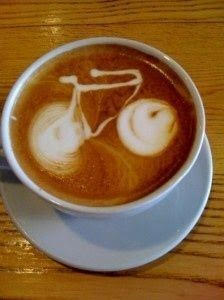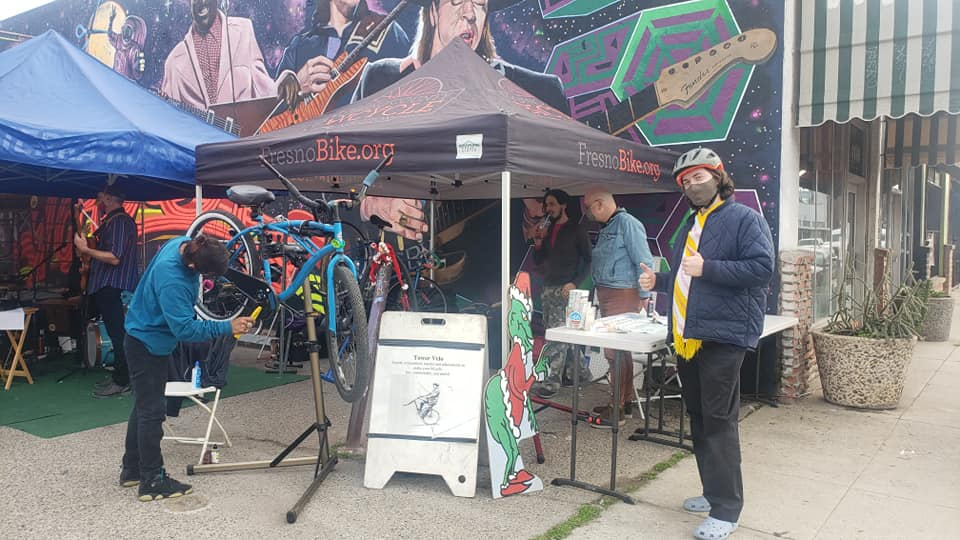January 2022
Happy New Year! Here’s hoping for a better year for everybody.
In this month’s Newsletter:
- Bike Café is on Tuesday, January 11, with a discussion of new bicycle and pedestrian bridges over the San Joaquin River with John Shelton, Executive Officer of the San Joaquin River Conservancy
- We take a look back at some of the accomplishments by FCBC in 2021
- In our ongoing series on bicycle infrastructure, we look at who sets the design standards for bicycle facilities
- The next Fresno Bike Station fix-your-own-bike event in on Sunday, January 16
- The next chapter from the pending book by Juan Flores on bicycling in Fresno describes the Kearney Museum and the ride there along Kearney Boulevard
- The FCBC Board election results are announced, and the next Board meeting is on January 20

FCBC Bike Café
The next Bike Café on “Bike Bridges on the San Joaquin River” is scheduled forJanuary 11, 2022 at 7:00 pm. John Shelton, Executive Officer of the San Joaquin River Conservancy, will be discussing future bicycle and pedestrian bridges over the San Joaquin River between State Routes 41 and 99. Register here to get the Zoom link.
Thanks to everyone who completed the recent survey for future Bike Café topics. You may continue to suggest topics by sending them to events@fresnobike.org.
A Look Back at 2021
Last year was another atypical year for FCBC with the ongoing COVID-19 pandemic. In normal times the FCBC calendar would be full of in-person Smart Cycling classes, participation in parades and other public events, Bike Month activities, and group rides. Instead, it was a more subdued year, with FCBC focusing its energy on developing a new strategic plan to provide the direction for the next 5 years and putting on the MOTHERLODE virtual film screening. Here are some highlights of the year:
- March - developed new mission, vision, and guiding principles for FCBC
- May - Bike Month with the MOTHERLOAD screen and panel discussion and a virtual Smart Cycling class conducted in collaboration with the U.S Green Building Council Central California
- July - launched the monthly Bike Café and partnered with Fresno County Historical Social for a group ride and guided tour of the Kerman Mansion Museum
- November - launched the Fresno Bicycle Station fix-your-own-bike (FYOB) events in conjunction with the Van Ness Village Vendor Fairs in the Tower District
In next month’s Newsletter, we’ll take a look at the plans for FCBC for 2022. The FCBC Board will be holding their annual retreat in mid-January to plan the events for the year.
Bicycle Infrastructure: Design Standards
As with other types of transportation infrastructure, there are design standards and guidelines that public agencies must follow in designing bikeways. The two key documents to which all public bikeways must conform are the Caltrans Highway Design Manual (HDM) and the California Manual on Uniform Traffic Control Devices (CA MUTCD), in accordance with Streets and Highway Code 891 and California Vehicle Code 21400. Consistency of design is important for safety because users will develop an expectation for each type of bicycle facility, signal, signing, or striping pattern. Doing so will also provide a measure of design immunity for the government agency having jurisdiction should litigation result from usage of the facility.
The HDM defines the minimum standards of the four types of bicycle facilities:
- Class I, bike path
- Class II, bike lane
- Class III, bike route
- Class IV, separated bikeway
Such standards include pavement width, slopes, distance to obstructions, and drainage.
Caltrans is also responsible for the CA MUTCD, which is based on the federal MUTCD with some modifications tailored for use in California. The CA MUTCD provides guidelines for the installation of traffic control devices, including signs, signals, striping, and other types of pavement markings. Any proposed changes are reviewed by theCalifornia Traffic Control Devices Committee (CtCDC), whose makeup includes local agencies, Caltrans, Federal Highway Administration (FHWA), and at-large members. Any newly proposed device needs approval by the CTCDC and may also need to go through an experimental process. For example, placing a green background on a sharrow does not conform to the CA MUTCD as the FHWA has granted interim approval for the use of green paint only in bike lanes. Using green paint in a facility that is not a bike lane, such as in vehicular lanes where sharrows are placed, would require going through the experimental process through the FHWA.
NACTO is the National Association of City Traffic Officials, and the City of Fresno is a member city. NACTO has developed detailed guidance for more sustainable, accessible, and equitable streets. In 2014 Caltrans endorsed the NACTO Urban Street Design Guide and Urban Bikeway Design Guide. This did not grant blanket approval of all the treatments in the guides, but over the past several years, many of the treatments have been incorporated into Caltrans guidance.
In next month’s Newsletter, we’ll start taking a look at the different types of bicycle facilities and their appropriate applications.
Fresno Bike Station
The Fresno Bike Station allows bike owners to learn how to repair their own bikes with help from experienced mechanics, including FCBC member Julie Congi and Tower Velo owner Chris Eacock. The last event was on December 12, and the next event will be on Sunday, January 16 at the Van Ness Village Vendor Fair.
Upcoming Book on Bicycling in Fresno
Below is the fifth chapter in the book that FCBC Board Member Juan Flores is writing on bicycling in Fresno. Juan welcomes any comments, corrections, and constructive criticism at juan@fresnobike.org. Previous chapters can be viewed on the FCBC website.
The Ride to Kearney Mansion
Kearney Mansion sits at the end of Kearney Boulevard, an old palm tree-lined street that was the original entrance to this mansion. Throughout the Central Valley of California, there are many stately palm tree-lined streets that were once the entrances to mansions of rich farmers. But once the magnificent homes disappeared, the palm tree lined streets remained as grand entrances leading to nowhere in particular, just reminders of bygone eras. M, Theo Kearney originally intended his mansion to be a much larger structure to be known as Chateau Fresno. The larger structure was never built. The mansion that was built is now part of the local park system, and docents regularly offer tours.
The Kearney Mansion is located seven miles west of downtown Fresno. It consists of two buildings, a main residence and adjoining servants' quarters. The two buildings are designed in the French Renaissance style using materials indigenous to the area. Both buildings have a basic rectangular form with walls of two-foot-thick adobe brick covered with a thin coat of plaster for waterproofing.
The present-day "mansion" was not intended to be Kearney's main residence, but was meant to be the home of the caretaker. Kearney lived in this residence while his much larger palace was being built. But alas, he died before his castle was completed. At the time of his death in 1906, only the caretaker’s residence and the servants' quarters had been completed.

The bike ride to Kearney Mansion can begin where Kearney Boulevard begins at its intersection with Fresno Street. As you ride down Kearney Boulevard, you pass by St. Alphonsus Church, one of the oldest churches in Fresno, where many families had their wedding ceremonies and baptisms, and where many funeral masses celebrated the end of generations.
You can also begin your ride at Chandler Airport, a private airport, with a coffee at Flight Line Café inside of Chandler Airport. You will probably have an easier time with parking at the airport. After a hearty breakfast, you can begin your bike ride and continue on to Kearney Mansion.
The ride to Kearney Mansion is 6.4 miles and takes approximately 33 minutes by bike. As you exit Chandler Airport, the most shaded and safest route would be to ride on the north frontage road heading west because the south frontage road is for the city bus route east of Crystal Avenue. Between South Marks Avenue and South Cornelia Avenue, Kearney Boulevard deviates south to bypass West Madison Avenue. As you approach Marks Avenue, merge left to stay on the scenic Kearney Boulevard route and remain on the north frontage road. At Blythe Avenue, cross the street to ride on the south frontage road where the bike route is. Stay on Kearny Boulevard as it merges with West Madison Avenue and continue on the bike path, the left of the street in order to enter Kearney Park.
Kearney Mansion Museum has a secured porch where you can leave your bicycle and then begin the inside guided tour led by Fresno County Historical Society tour guides.
Board Elections Results
Board elections were held last month, and Tony Molina was reelected Board Chair. Newly elected as Vice Chair was Jeremy Doyel, who was previously an At Large Director. Juan Flores, the previous Vice Chair, was elected Membership Coordinator. New to the Board is Amy Zehring as an At Large Director. Returning to the Board in their current positions were Ed Smith as Past Chair and Secretary, Jack Nelson as Treasurer, and John Liu and Thor Smith as At Large Directors.
Membership
If you are not yet a member of FCBC or need to renew, please visit https://fresnobike.org/join to become a member or renew your membership.
Have a comment or suggestion? Contact us at info@fresnobike.org
